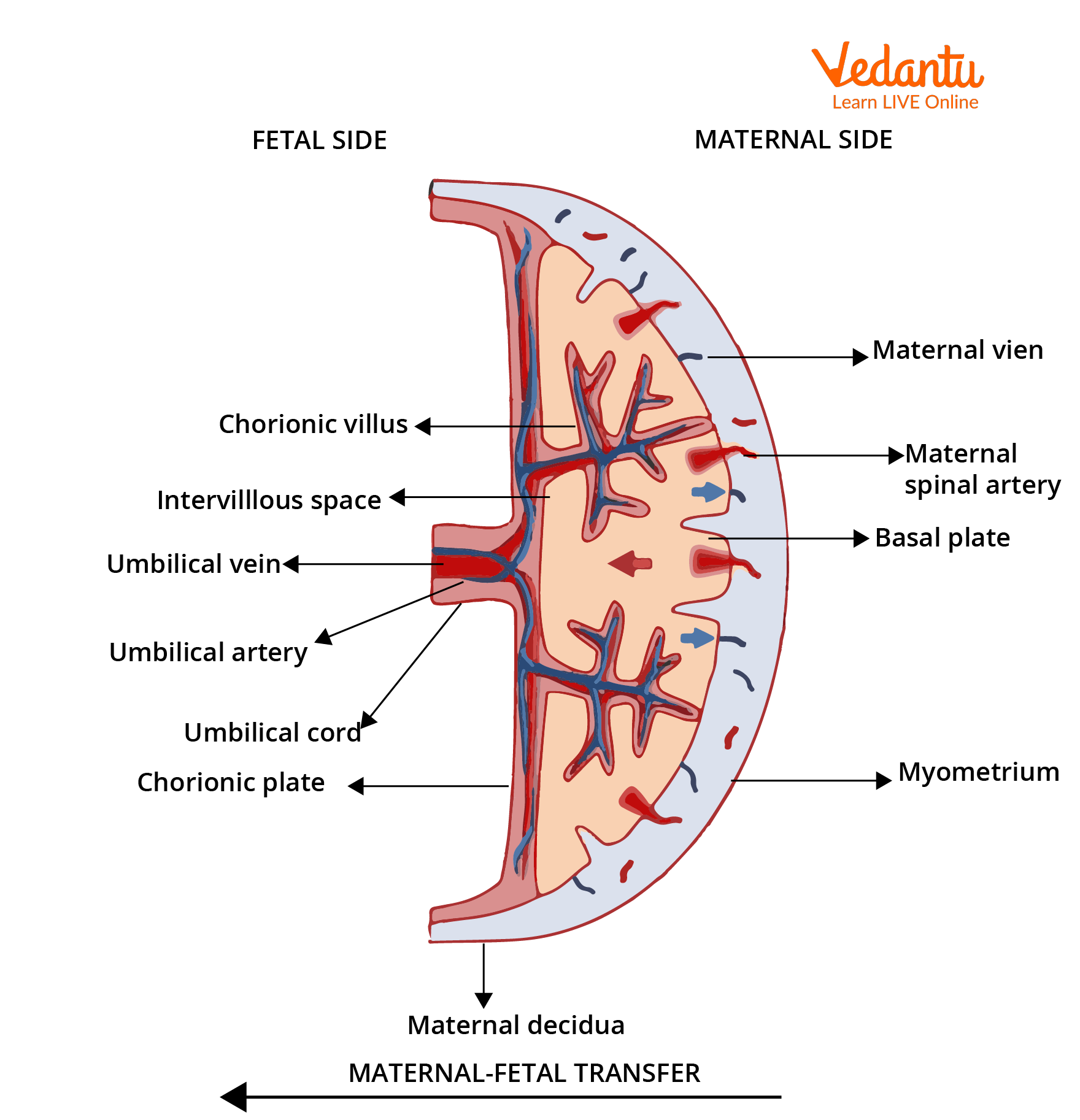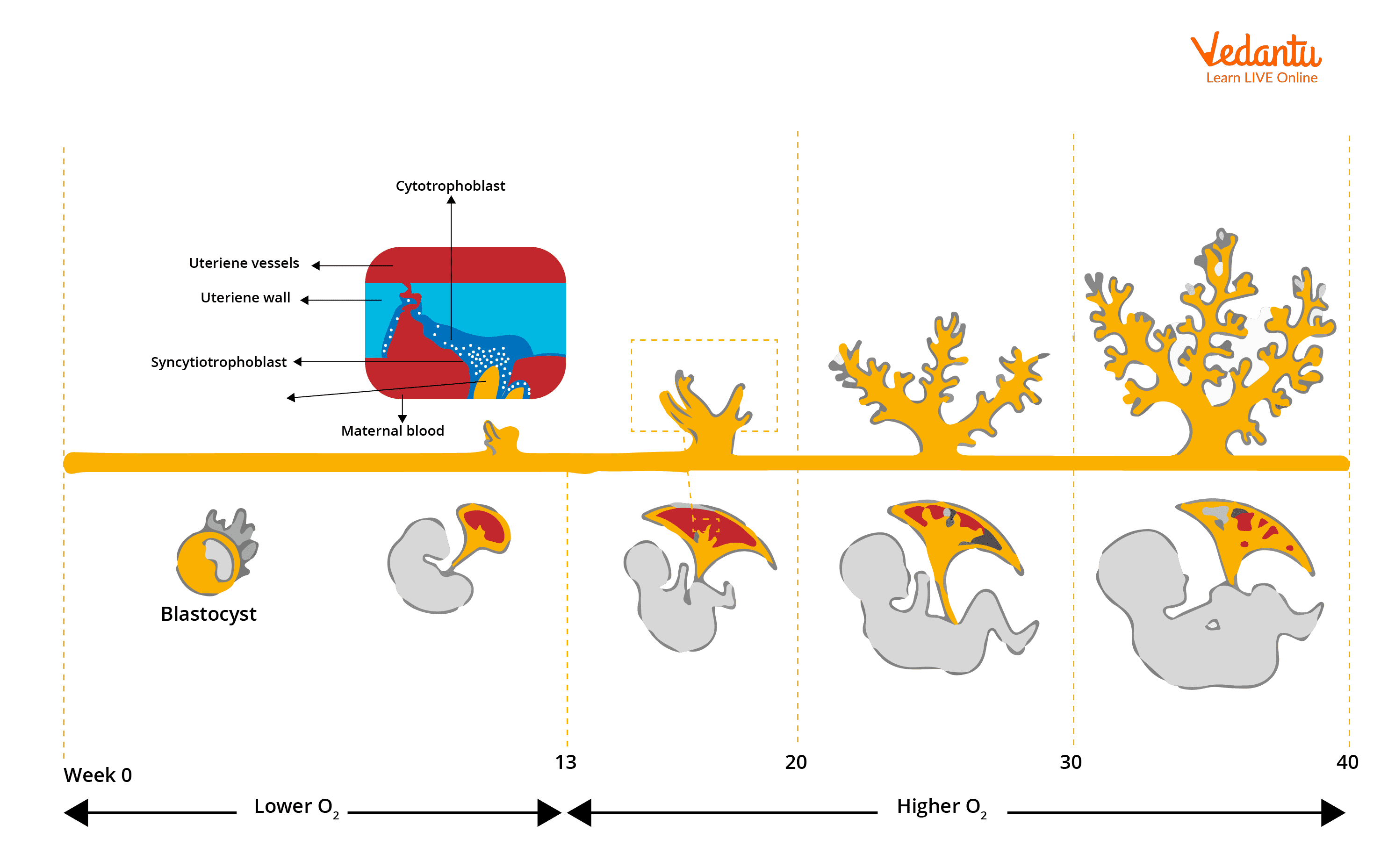What is the structure and function of the placenta in humans?
The placenta is a unique organ that forms during pregnancy in mammals, connecting the developing fetus to the maternal uterus. It plays a crucial role in supporting fetal growth, nutrient transfer, waste removal, and hormone production. Understanding the placenta is essential in fields like medicine, reproductive biology, and human development as it impacts both maternal and fetal health.
What is Placenta?
Placenta is a temporary but vital organ that develops in the uterus during pregnancy. Its main function is to act as a bridge between the mother and fetus, allowing the exchange of nutrients, gases, hormones, and waste products. In Hindi, placenta meaning is “गर्भनाल” (placenta meaning in Hindi). The placenta supports fetal development until birth when it is expelled from the body after labour.
Structure and Development of the Placenta
The placenta begins forming soon after implantation of the fertilized egg. It consists of both maternal and fetal tissues, making it a unique organ with combined origin. The fetal part, called the chorion, connects to the umbilical cord, while the maternal part lines the uterus wall. The placenta’s structure consists of villi, blood vessels, and membranes that facilitate efficient transport of materials.

Function of Placenta
The main function of placenta is to ensure the growing fetus receives nutrients, oxygen, and hormones required for healthy development. At the same time, it removes carbon dioxide and waste products. The placenta also produces several hormones, including progesterone and human chorionic gonadotropin (hCG), which are essential for maintaining pregnancy.
- Gas exchange: Transfers oxygen to the fetus and removes carbon dioxide.
- Nutrient absorption: Transports glucose, amino acids, and fats.
- Waste removal: Eliminates fetal wastes into maternal circulation.
- Hormone production: Supports maternal adaptations and fetal growth.
- Immune protection: Acts as a barrier to many infections.
Types and Positions of Placenta
Doctors categorize placentas based on their point of attachment to the uterine wall. These positions can influence pregnancy outcomes and are often identified via ultrasound.
- Anterior Placenta: Attached to the front wall of the uterus. “Placenta anterior” is commonly detected; some people wonder about placenta anterior means boy or girl, but position does not determine fetal gender.
- Posterior Placenta: Located on the back wall (placenta posterior). “Posterior placenta means boy or girl” is a common myth with no scientific basis.
- Fundal Placenta: Attached to the top wall of the uterus.
- Low Lying Placenta: Close to or covering the cervix, which may require monitoring (“low lying placenta”).
Placenta Previa
Placenta previa is a special type where the placenta partially or wholly covers the cervix. This condition can cause bleeding during pregnancy or delivery and may lead to a cesarean section.
- Complete previa: Entirely covers the cervix.
- Partial previa: Partially covers the cervix.
- Marginal previa: Edge touches, but does not cover, the cervix.
Other Variations
- Placenta accreta: The placenta attaches too deeply into the uterine wall, often leading to complications at birth.
- Circumvallate placenta: The placenta has a raised edge, which can affect its function.
Placental Development Process
The formation of the placenta involves several coordinated stages as the embryo implants and starts growing. This process ensures vital connections between mother and baby are established efficiently.

- Implantation: The blastocyst embeds in the uterine wall.
- Trophoblast formation: Cells differentiate to create the outer membrane (trophoblast), which invades maternal tissue.
- Chorionic villi development: Finger-like projections form to increase surface area for exchange.
- Blood vessel growth: Networks form, connecting the fetus and mother for nutrient and waste exchange.
- Maturation: The placenta fully develops and functions until birth.
For more about fetal development, visit our page on embryo development and implantation in human.
Placental Disorders and Medical Relevance
Many medical conditions are associated with abnormal placental structure or position. These can affect both maternal and fetal health, sometimes requiring special care or intervention.
- Placenta previa: May cause heavy bleeding and require cesarean delivery.
- Placenta accreta: Placenta is abnormally adherent, risking hemorrhage during removal.
- Circumvallate placenta: Increases risks of preterm birth or fetal growth problems.
- Low lying placenta: Monitored via ultrasound for maternal safety.
Learn more about female reproductive system and structural adaptations on Vedantu.
Types of Placenta in Animals
Placental types differ across mammals based on their structure and attachment degree. In animals, these variations are important for evolutionary studies and veterinary medicine.
- Discoidal placenta: As in humans, forms a disc-like structure.
- Cotyledonary placenta: Found in cows and sheep with patch-like attachments.
- Diffuse placenta: Horses and pigs have villi spread over a large area.
- Zonary placenta: Present in dogs and cats, forming a belt around the fetus.
Visit our animal kingdom classification page to see how placental evolution fits into animal diversity.
Placenta After Birth
After childbirth, the placenta is expelled from the uterus in a stage known as “afterbirth.” Medical professionals examine the placenta to ensure its complete expulsion and to check for signs of disorders. In some traditions, the placenta holds cultural or symbolic meaning and may be treated in special ways post-delivery.
Placenta Diagram – Simplified Structure
A clear placenta diagram shows the chorionic villi, maternal and fetal blood vessels, and the umbilical cord. Visualizing these components helps biology students understand material exchange during pregnancy.
Explore other human anatomy diagrams on Vedantu, like our uterus diagram or parts of the brain for holistic learning.
Placenta Extract and Applications
Placenta extract gel is used in some medical and cosmetic products to promote healing or skin regeneration. While research continues, these applications highlight the biological significance of placental tissues beyond pregnancy, especially in the fields of medicine and health.
Page Summary
The placenta is a vital organ during pregnancy, enabling the exchange of essential substances between mother and fetus. By studying its types, functions, and disorders, students gain insights into reproductive biology and human health. Interested learners can explore related topics and diagrams on Vedantu for deeper understanding and academic success.


FAQs on All About Placenta: Definition, Structure, Types and Uses
1. What is placenta and what is its function?
The placenta is a temporary organ that forms during pregnancy to connect the developing fetus to the mother’s uterus. Its main function is to provide nutrients, oxygen, and waste removal for the fetus.
- Transfers oxygen and nutrients from maternal blood to the fetus
- Removes carbon dioxide and wastes from fetal blood
- Produces hormones such as hCG, progesterone, and estrogen
- Acts as a partial barrier against infections
2. How is the placenta formed?
The placenta is formed by the combination of fetal tissue (chorion) and maternal tissue (endometrium). The process is called placentation.
- After fertilization, the embryo implants in the uterine wall
- The outer layer of the embryo, called the trophoblast, invades the endometrium
- Maternal blood vessels and fetal villi interdigitate to create the placental structure
3. What are the main functions of the placenta?
The placenta performs several vital functions during pregnancy. These include:
- Exchange of gases: Supplies oxygen to the fetus and removes carbon dioxide
- Nutrient transfer: Delivers glucose, amino acids, fatty acids, and vitamins
- Excretion of wastes: Removes urea and other wastes
- Hormone secretion: Produces hCG, progesterone, estrogen, and human placental lactogen
- Protection: Acts as a partial barrier against infections and harmful substances
4. What hormones are produced by the placenta?
The placenta acts as an endocrine organ and produces several hormones important for pregnancy, including:
- Human Chorionic Gonadotropin (hCG): Maintains the corpus luteum
- Progesterone: Prepares and maintains the uterine lining
- Estrogen: Promotes growth of uterine muscles and mammary glands
- Human Placental Lactogen (hPL): Regulates metabolism and prepares breasts for lactation
5. What are the types of placenta based on shape and attachment?
Based on shape and attachment, placentas can be classified into several types:
- Discoidal placenta (e.g., in humans): Disc-shaped attachment
- Diffuse placenta (e.g., horses, pigs): Attachment over the entire uterine surface
- Cotyledonary placenta (e.g., cows, sheep): Multiple button-like areas (cotyledons)
- Zonary placenta (e.g., dogs, cats): Band-shaped attachment
6. How does the placenta protect the developing fetus?
The placenta protects the fetus by acting as a selective barrier and immune shield.
- Prevents mixing of maternal and fetal blood
- Blocks many harmful substances and pathogens
- Transfers maternal antibodies (IgG) for passive immunity
7. What happens to the placenta after birth?
After the baby is born, the placenta is expelled from the mother's body in a process known as the third stage of labor or afterbirth.
- The uterus contracts to detach the placenta from its wall
- The placenta and membranes are delivered through the vagina
- This usually occurs within 15-30 minutes after delivery
8. What is placenta previa?
Placenta previa is a condition where the placenta partially or completely covers the cervix, the opening to the uterus.
- Can cause painless vaginal bleeding during pregnancy
- May require bed rest or cesarean section for delivery
- Increases risk of complications for mother and baby
9. Why is placenta called an endocrine organ?
The placenta is called an endocrine organ because it secretes hormones that regulate pregnancy and fetal development.
- Produces hormones such as hCG, progesterone, estrogen, and hPL
- Regulates maternal metabolism and prepares the body for lactation
- Supports growth and maintenance of pregnancy
10. What are the structural components of the placenta?
The placenta has both maternal and fetal components, together facilitating exchange.
- Fetal part: Chorionic villi (contain fetal blood vessels)
- Maternal part: Decidua basalis (part of the endometrium)
- Intervillous spaces filled with maternal blood










